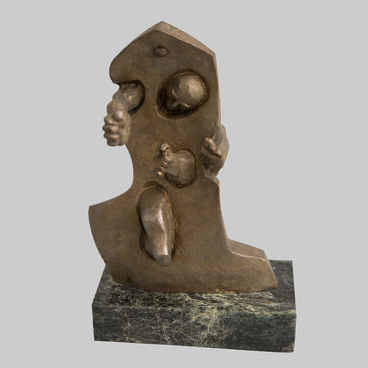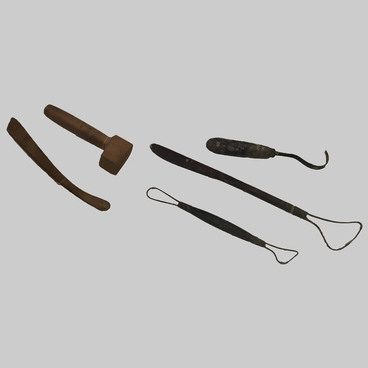The sculptures included in the Power of the Beast series are the result of an analytical study of the biblical and mythological subjects of the Book of Job, on the sketches of which Ernst Neizvestny worked at the turn of the centuries. It is known that in addition to sculptural compositions, the master created graphic works with great inspiration. As far back as during the Soviet period of his work, novel Crime and Punishment by Dostoevsky with illustrations created by Neizvestny, was published. A decade later, already while living in the USA, the master created graphic series for one of San Francisco art galleries. The illustrations for the Book of Job were a continuation of the artist’s Old Testament graphic cycle. The first sketches were made for Ecclesiastes, later appeared drawings for the Book of Prophets.
Both in graphics and in sculptural plots of Ernst Neizvestny, the key element is a man who is constrained by internal tension on the verge of a stupor. In all of the master’s works, realistic sculptural details are intertwined with abstract and grotesque elements. According to the reviews of observers, the sculptures are so textured that you can look at them endlessly. The artist’s amazing power over bronze forms and the ability to transform them smoothly allowed him to create incredible works.
The cycle Power of the Beast was released in 1999. In Greek mythology, a satyr is a creature whose image combines features of a person and a cloven-hoofed animal. Cheerful and joyful, satyrs were famous for their passion for debauchery and addiction to alcohol. They accompanied the god of wine Dionysus and devoted all their free time to drunkenness and flirting with nymphs. They were never sad, never tired of noise and fun, and did not think about a different life.
The satyr by Neizvestny, once a reckless creature, is overestimating the meaning of life and thinking about its purpose. The animal and the human being are fighting in it. It can be seen from the face of satyr that intellectual rudiments are prevailing, and the spiritual component is trying to suppress biological forms with all its might.
The sculptures from the series The Power of the Beast act as a kind of culmination of the artist’s understanding of human nature, the essence of which he discovered during his work on the Book of Job. Subsequently, the philosophical perception of biblical postulates helped the artist during the work on his famous Tree of Life. In the author’s interpretation, the beast is a prototype of the devil. In biblical scriptures, the devil is presented as a creature created by a complex combination of various animals.
The sculptor believes that within each person there is a certain animal component and through life, the “dark” animal essence fights with the good nature. All the negative qualities of people - envy, anger, greed, hypocrisy - are generated by the bestial force that underlies the survival instinct. The works of Ernst Neizvestny, included in the series Power of the Beast, symbolize humanity, its best and worst sides. In his works, the author leads the viewer to philosophical reflection on how strong the power of the beast is and what actions need to be taken so that it does not prevail over the nature of love and kindness.
Both in graphics and in sculptural plots of Ernst Neizvestny, the key element is a man who is constrained by internal tension on the verge of a stupor. In all of the master’s works, realistic sculptural details are intertwined with abstract and grotesque elements. According to the reviews of observers, the sculptures are so textured that you can look at them endlessly. The artist’s amazing power over bronze forms and the ability to transform them smoothly allowed him to create incredible works.
The cycle Power of the Beast was released in 1999. In Greek mythology, a satyr is a creature whose image combines features of a person and a cloven-hoofed animal. Cheerful and joyful, satyrs were famous for their passion for debauchery and addiction to alcohol. They accompanied the god of wine Dionysus and devoted all their free time to drunkenness and flirting with nymphs. They were never sad, never tired of noise and fun, and did not think about a different life.
The satyr by Neizvestny, once a reckless creature, is overestimating the meaning of life and thinking about its purpose. The animal and the human being are fighting in it. It can be seen from the face of satyr that intellectual rudiments are prevailing, and the spiritual component is trying to suppress biological forms with all its might.
The sculptures from the series The Power of the Beast act as a kind of culmination of the artist’s understanding of human nature, the essence of which he discovered during his work on the Book of Job. Subsequently, the philosophical perception of biblical postulates helped the artist during the work on his famous Tree of Life. In the author’s interpretation, the beast is a prototype of the devil. In biblical scriptures, the devil is presented as a creature created by a complex combination of various animals.
The sculptor believes that within each person there is a certain animal component and through life, the “dark” animal essence fights with the good nature. All the negative qualities of people - envy, anger, greed, hypocrisy - are generated by the bestial force that underlies the survival instinct. The works of Ernst Neizvestny, included in the series Power of the Beast, symbolize humanity, its best and worst sides. In his works, the author leads the viewer to philosophical reflection on how strong the power of the beast is and what actions need to be taken so that it does not prevail over the nature of love and kindness.



